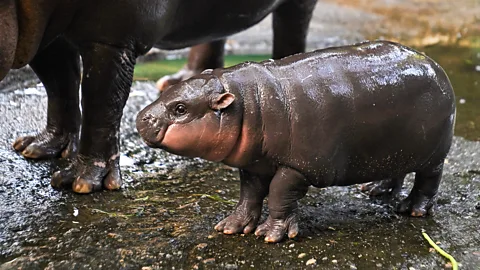 Getty Images
Getty ImagesThe outstanding Mu Deng has attracted much attention. But in the wild, his species is quietly disappearing.
But Mo Dang is a member of vulnerable and elusive species. Choeropsis liberiensiswhich is native to West Africa. And while his fame grows, his relatives in the wild are becoming increasingly rare in their small habitat.
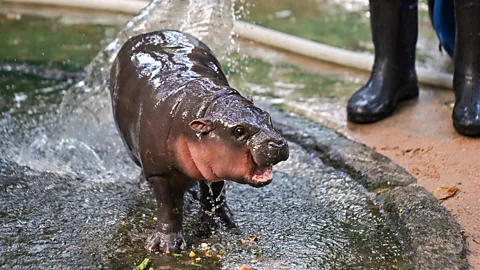 Getty Images
Getty ImagesAn elusive mammal
In their natural habitat, pygmy hippos live in forested areas along rivers, streams, and marshes to keep their skin moist. They mainly eat Herbs, leaves, shoots and fruitsfeeding on vegetation at night and around dusk and dawn.
These charismatic animals have long been a part of Culture and folklore West Africa According to a Liberian legendanimals find their way through the forest at night carrying diamonds in their mouths to light the way. And a story in the Ivory Coast says that anyone who sees the tail of a dwarf hippopotamus and laughs goes mad.
But despite their place in local culture, pygmy hippos are mysterious and not as well studied as their larger cousins. They are mainly Nocturnal, secretive and relatively isolatedand conducting research in West African forests is difficult.
As a result of their secretive nature, experts have only been able to learn much about pygmy hippos from camera traps, tracking with footprints and other marks, dung samples, and modeling to estimate numbers and discover their movements. Pygmy hippopotamuses, kept in captivity as part of breeding programs, have also increased the scientific understanding of these mammals. The non-profit organization Fauna & Flora International and the Forestry Development Agency of Liberia have even used environmental DNA.eDNATechnology to search for evidence of organisms in southeastern Liberia’s river systems – a technique that involves analyzing DNA found in their habitat.
A disappearing habitat
Although the pygmy hippo has been considered a protected species for decades, Bougie Eli Bandema, a researcher at the Swiss Scientific Research Center in Côte d’Ivoire, says that research efforts have been limited since 2010, when pressures on its habitat increased significantly, increased.
Large areas of original forest have been destroyed or destroyed, especially in Côte d’Ivoire. For example, parts have been razed to create commercial farms Palm oil, cocoa and rubber. Pressure for wood is another threat. Liberia’s forests have been extensively cleared and the country is in trouble To maintain control over illegal logging. Local people across the region also cut down trees for firewood.
But according to Bougie, a growing threat comes from illegal mineral extraction. In Tay National Park, people search for gold that is deposited in rivers and streams.
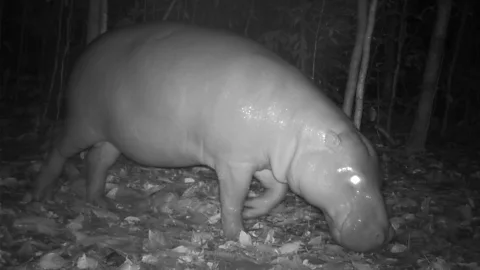 Animals and plants
Animals and plantsGabriela Flack, a veterinary consultant for dwarf hippos, says the extent of this deforestation and the destruction of their forest habitat makes it very difficult for dwarf hippos to survive in the wild. Species survival plan and part of the IUCN Hippopotamus Specialist Group. He explains that the species already has a naturally limited range, which makes it particularly vulnerable to this type of loss. “They have nowhere else to go,” says Flack. Their home ranges are getting smaller and smaller and there is less space for them to behave naturally and reproduce and meet ecosystem needs.
Dwarf hippos are also at risk of shrinking their habitat They hunted for their meat.
However, efforts to better understand and protect this endangered species continue.
The pygmy hippopotamus is legally protected within its range in all four West African countries, although the level of enforcement varies. “Côte d’Ivoire is probably the best-equipped region for this,” Flack says. Compared to Liberia and Sierra Leone, the country has been very stable politically and has more resources and better infrastructure.”
Bogui conducts research in Taï National Park The largest protected primary rainforest It is located in West Africa and is a UNESCO World Heritage Site. “The park provides the right habitat for the pygmy hippo, with food and most importantly, protection – even if it’s not 100 percent guaranteed,” he says. He estimates that between 800 and 1,000 people live there now.
Bougie says the Ivory Coast government has made conservation efforts, such as planting more trees and strengthening legislation to protect the pygmy hippo.
Neus Estela, West Africa Technical Specialist at Fauna & Flora, says the main goal of its conservation strategy is to connect all remaining populations of pygmy hippos. To this end, it has collaborated in a landscape-level assessment to identify potential conservation corridors in southeastern Liberia.
poverty and corruption Significant barriers remain to address habitat loss for these and other threatened species.
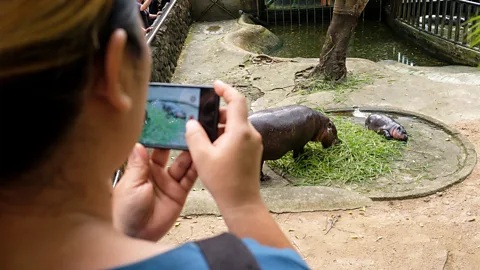 Getty Images
Getty ImagesOne of the solutions Fauna & Flora is working on with the government and communities in Liberia is to create a project REDD+ forest protection plan supported by the United Nations To help combat the drivers of deforestation and degradation, all while supporting local people’s livelihoods and respecting land rights.
Flack would like to see more conservation efforts involving local communities in West Africa. “There’s a lot of interest locally. They know the pygmy hippo is an iconic species, maybe a keystone species for the ecosystem. But the reality of conservation is that if there’s no infrastructure and resources to support it, people will process. to fight, no matter how eager or dedicated they are.”
To try to address this, a Pilot project With the support of Zoo Basel, it encourages unemployed young people living near the Gula forests in Sierra Leone and Liberia to become ambassadors for the endangered species. The Pygmy Rhino Foundation also trains community forest rangers In Sapo National Park To monitor and protect the pygmy hippo population
Despite years of study, both in captivity and in the wild, little is known about how pygmy hippos live. For example, Flock hopes to learn more about the size of their natural home range and whether they behave as well in captivity in the wild, he says.
The pygmy hippopotamus also likely plays an important role in its local ecosystem. Researchers speculate that, like the common hippo, the pygmy hippo might help Spread the seeds and recycle the nutrients By spreading manure and maybe even engineering river banks.
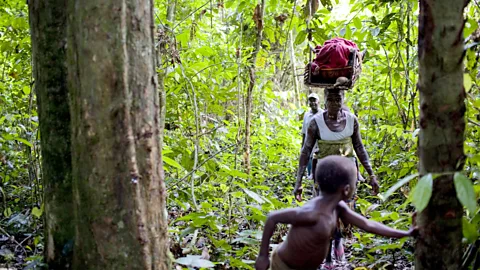 Getty Images
Getty ImagesZSL identified pygmy hippos as a conservation priority in 2007 There is an edge programbut told the BBC that he no longer does any significant work on the species.
There are about 450 pygmy hippos in captivity worldwide, Flack says. But they can attract intense attention Which can be uncomfortable or even harmful for such a shy creature. In the past few weeks, Mo Deng has been harassed by some visitors, leading to security Around his compound increased. Bogie points out that while zoos are a way to protect endangered species, it’s far better to leave their original habitat intact.
An updated IUCN assessment of pygmy hippos is due next year, and Flack predicts their numbers will decline again. “They’re still out there, we know that. But there are definitely populations that haven’t been seen in 20 years, and there’s no footprints, no dung, no teeth marks. Where do they go? Well, they are. leaving,” he says.
As Mu Deng captures hearts around the world, thousands of people like him are struggling.
Follow us for more science, technology, environment and health from the BBC Facebook and X.
#Deng #Shrinking #habitat #worlds #famous #hippopotamus
